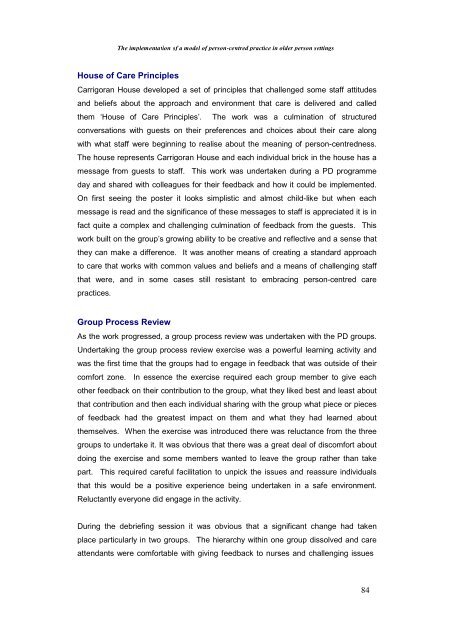The Implementation of a Model of Person-Centred Practice In Older ...
The Implementation of a Model of Person-Centred Practice In Older ...
The Implementation of a Model of Person-Centred Practice In Older ...
Create successful ePaper yourself
Turn your PDF publications into a flip-book with our unique Google optimized e-Paper software.
<strong>The</strong> implementation <strong>of</strong> a model <strong>of</strong> person-centred practice in older person settings<br />
House <strong>of</strong> Care Principles<br />
Carrigoran House developed a set <strong>of</strong> principles that challenged some staff attitudes<br />
and beliefs about the approach and environment that care is delivered and called<br />
them ‘House <strong>of</strong> Care Principles’. <strong>The</strong> work was a culmination <strong>of</strong> structured<br />
conversations with guests on their preferences and choices about their care along<br />
with what staff were beginning to realise about the meaning <strong>of</strong> person-centredness.<br />
<strong>The</strong> house represents Carrigoran House and each individual brick in the house has a<br />
message from guests to staff. This work was undertaken during a PD programme<br />
day and shared with colleagues for their feedback and how it could be implemented.<br />
On first seeing the poster it looks simplistic and almost child-like but when each<br />
message is read and the significance <strong>of</strong> these messages to staff is appreciated it is in<br />
fact quite a complex and challenging culmination <strong>of</strong> feedback from the guests. This<br />
work built on the group’s growing ability to be creative and reflective and a sense that<br />
they can make a difference. It was another means <strong>of</strong> creating a standard approach<br />
to care that works with common values and beliefs and a means <strong>of</strong> challenging staff<br />
that were, and in some cases still resistant to embracing person-centred care<br />
practices.<br />
Group Process Review<br />
As the work progressed, a group process review was undertaken with the PD groups.<br />
Undertaking the group process review exercise was a powerful learning activity and<br />
was the first time that the groups had to engage in feedback that was outside <strong>of</strong> their<br />
comfort zone. <strong>In</strong> essence the exercise required each group member to give each<br />
other feedback on their contribution to the group, what they liked best and least about<br />
that contribution and then each individual sharing with the group what piece or pieces<br />
<strong>of</strong> feedback had the greatest impact on them and what they had learned about<br />
themselves. When the exercise was introduced there was reluctance from the three<br />
groups to undertake it. It was obvious that there was a great deal <strong>of</strong> discomfort about<br />
doing the exercise and some members wanted to leave the group rather than take<br />
part. This required careful facilitation to unpick the issues and reassure individuals<br />
that this would be a positive experience being undertaken in a safe environment.<br />
Reluctantly everyone did engage in the activity.<br />
During the debriefing session it was obvious that a significant change had taken<br />
place particularly in two groups. <strong>The</strong> hierarchy within one group dissolved and care<br />
attendants were comfortable with giving feedback to nurses and challenging issues<br />
84
















